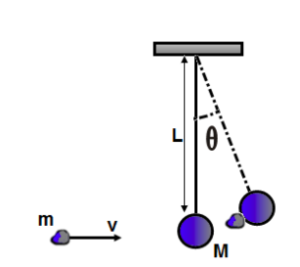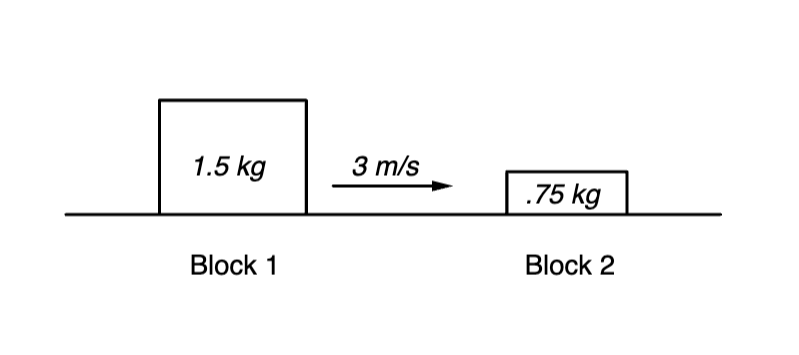0 attempts
0% avg
UBQ Credits
| Step | Derivation / Formula | Reasoning |
|---|---|---|
| 1 | \[m_1 = 4\,\text{kg},\; m_2 = 7\,\text{kg},\; v_i = 10\,\text{m/s}\] | Identify the masses and the initial velocity \(v_i\) of the \(4\,\text{kg}\) mass. The \(7\,\text{kg}\) mass is initially at rest. |
| 2 | \[p_{x,i}=m_1 v_i = 4(10)=40,\; p_{y,i}=0\] | Calculate the initial momentum components. Motion is purely horizontal to the right, so the vertical component is zero. |
| 3 | \[v_{x2}=2\cos22^{\circ},\; v_{y2}=-2\sin22^{\circ}\] | Resolve the \(7\,\text{kg}\) mass’s given final speed (\(2\,\text{m/s}\)) into horizontal and vertical components. The vertical component is negative (below the horizontal). |
| 4 | \[v_{x2}\approx1.854,\; v_{y2}\approx-0.749\] | Numerical evaluation of the trigonometric components. |
| 5 | \[4 v_{x1}+7 v_{x2}=40\] | Apply conservation of momentum in the \(x\)-direction: total initial \(p_x\) equals total final \(p_x\). |
| 6 | \[4 v_{y1}+7 v_{y2}=0\] | Apply conservation of momentum in the \(y\)-direction: initial \(p_y\) is zero, so the final \(p_y\) must also be zero. |
| 7 | \[v_{x1}=\frac{40-7 v_{x2}}{4}\] | Solve the \(x\)-momentum equation for the unknown horizontal component \(v_{x1}\) of the \(4\,\text{kg}\) mass. |
| 8 | \[v_{x1}=\frac{40-7(1.854)}{4}\approx6.755\,\text{m/s}\] | Substitute \(v_{x2}\) and compute \(v_{x1}\). |
| 9 | \[v_{y1}=-\frac{7 v_{y2}}{4}\] | Rearrange the \(y\)-momentum equation to isolate the vertical component \(v_{y1}\) of the \(4\,\text{kg}\) mass. |
| 10 | \[v_{y1}=-\frac{7(-0.749)}{4}\approx1.311\,\text{m/s}\] | Insert \(v_{y2}\) and calculate \(v_{y1}\). The result is positive, meaning the mass moves upward after the collision. |
| 11 | \[v_x=\sqrt{v_{x1}^2+v_{y1}^2}\] | Use the Pythagorean relation to find the magnitude \(v_x\) of the final velocity of the \(4\,\text{kg}\) mass. |
| 12 | \[v_x=\sqrt{(6.755)^2+(1.311)^2}\approx6.88\,\text{m/s}\] | Compute the numerical value of the speed. |
| 13 | \[\theta=\tan^{-1}\!\left(\frac{v_{y1}}{v_{x1}}\right)\] | Determine the direction angle \(\theta\) measured above the horizontal. |
| 14 | \[\theta=\tan^{-1}\!\left(\frac{1.311}{6.755}\right)\approx11^{\circ}\] | Evaluate the inverse tangent to find the angle. |
| 15 | \[\boxed{v_x\approx6.9\,\text{m/s},\;\theta\approx11^{\circ}\,\text{above horizontal}}\] | Present the final boxed answer: the speed and its angle relative to the horizontal. |
Just ask: "Help me solve this problem."
A man weighing \( 700 \) \( \text{N} \) and a woman weighing \( 400 \) \( \text{N} \) have the same momentum. What is the ratio of the man’s kinetic energy \( K_m \) to that of the woman \( K_w \)?
A \(15 \, \text{g}\) marble moves to the right at \(3.5 \, \text{m/s}\) and makes an elastic head-on collision with a \(22 \, \text{g}\) marble. The final velocity of the \(22 \, \text{g}\) marble is \(2.0 \, \text{m/s}\) to the right, and the final velocity of the \(15 \, \text{g}\) marble is \(5.4 \, \text{m/s}\) to the left. What was the initial velocity of the \(22 \, \text{g}\) marble?
An object at rest suddenly explodes into two fragments (\(m_1\) and \(m_2\)) by an explosion. Fragment \(m_1\) acquires \(3\) times the kinetic energy of the other. What is the ratio of \(m_1\) to \(m_2\)?

A \(20 \, \text{g}\) piece of clay moving at a speed of \(50 \, \text{m/s}\) strikes a \(500 \, \text{g}\) pendulum bob at rest. The length of a string is \(0.8 \, \text{m}\). After the collision, the clay-bob system starts to oscillate as a simple pendulum.

Block 2 initially is at rest. Block 1 travels towards block 2 and collides with Block 2 as shown above. Find the final velocities of both blocks assuming the collision is elastic.
\(6.9\,\text{m/s}\)
\(11^{\circ}\text{ above horizontal}\)
By continuing you (1) agree to our Terms of Use and Terms of Sale and (2) consent to sharing your IP and browser information used by this site’s security protocols as outlined in our Privacy Policy.
| Kinematics | Forces |
|---|---|
| \(\Delta x = v_i t + \frac{1}{2} at^2\) | \(F = ma\) |
| \(v = v_i + at\) | \(F_g = \frac{G m_1 m_2}{r^2}\) |
| \(v^2 = v_i^2 + 2a \Delta x\) | \(f = \mu N\) |
| \(\Delta x = \frac{v_i + v}{2} t\) | \(F_s =-kx\) |
| \(v^2 = v_f^2 \,-\, 2a \Delta x\) |
| Circular Motion | Energy |
|---|---|
| \(F_c = \frac{mv^2}{r}\) | \(KE = \frac{1}{2} mv^2\) |
| \(a_c = \frac{v^2}{r}\) | \(PE = mgh\) |
| \(T = 2\pi \sqrt{\frac{r}{g}}\) | \(KE_i + PE_i = KE_f + PE_f\) |
| \(W = Fd \cos\theta\) |
| Momentum | Torque and Rotations |
|---|---|
| \(p = mv\) | \(\tau = r \cdot F \cdot \sin(\theta)\) |
| \(J = \Delta p\) | \(I = \sum mr^2\) |
| \(p_i = p_f\) | \(L = I \cdot \omega\) |
| Simple Harmonic Motion | Fluids |
|---|---|
| \(F = -kx\) | \(P = \frac{F}{A}\) |
| \(T = 2\pi \sqrt{\frac{l}{g}}\) | \(P_{\text{total}} = P_{\text{atm}} + \rho gh\) |
| \(T = 2\pi \sqrt{\frac{m}{k}}\) | \(Q = Av\) |
| \(x(t) = A \cos(\omega t + \phi)\) | \(F_b = \rho V g\) |
| \(a = -\omega^2 x\) | \(A_1v_1 = A_2v_2\) |
| Constant | Description |
|---|---|
| [katex]g[/katex] | Acceleration due to gravity, typically [katex]9.8 , \text{m/s}^2[/katex] on Earth’s surface |
| [katex]G[/katex] | Universal Gravitational Constant, [katex]6.674 \times 10^{-11} , \text{N} \cdot \text{m}^2/\text{kg}^2[/katex] |
| [katex]\mu_k[/katex] and [katex]\mu_s[/katex] | Coefficients of kinetic ([katex]\mu_k[/katex]) and static ([katex]\mu_s[/katex]) friction, dimensionless. Static friction ([katex]\mu_s[/katex]) is usually greater than kinetic friction ([katex]\mu_k[/katex]) as it resists the start of motion. |
| [katex]k[/katex] | Spring constant, in [katex]\text{N/m}[/katex] |
| [katex] M_E = 5.972 \times 10^{24} , \text{kg} [/katex] | Mass of the Earth |
| [katex] M_M = 7.348 \times 10^{22} , \text{kg} [/katex] | Mass of the Moon |
| [katex] M_M = 1.989 \times 10^{30} , \text{kg} [/katex] | Mass of the Sun |
| Variable | SI Unit |
|---|---|
| [katex]s[/katex] (Displacement) | [katex]\text{meters (m)}[/katex] |
| [katex]v[/katex] (Velocity) | [katex]\text{meters per second (m/s)}[/katex] |
| [katex]a[/katex] (Acceleration) | [katex]\text{meters per second squared (m/s}^2\text{)}[/katex] |
| [katex]t[/katex] (Time) | [katex]\text{seconds (s)}[/katex] |
| [katex]m[/katex] (Mass) | [katex]\text{kilograms (kg)}[/katex] |
| Variable | Derived SI Unit |
|---|---|
| [katex]F[/katex] (Force) | [katex]\text{newtons (N)}[/katex] |
| [katex]E[/katex], [katex]PE[/katex], [katex]KE[/katex] (Energy, Potential Energy, Kinetic Energy) | [katex]\text{joules (J)}[/katex] |
| [katex]P[/katex] (Power) | [katex]\text{watts (W)}[/katex] |
| [katex]p[/katex] (Momentum) | [katex]\text{kilogram meters per second (kgm/s)}[/katex] |
| [katex]\omega[/katex] (Angular Velocity) | [katex]\text{radians per second (rad/s)}[/katex] |
| [katex]\tau[/katex] (Torque) | [katex]\text{newton meters (Nm)}[/katex] |
| [katex]I[/katex] (Moment of Inertia) | [katex]\text{kilogram meter squared (kgm}^2\text{)}[/katex] |
| [katex]f[/katex] (Frequency) | [katex]\text{hertz (Hz)}[/katex] |
General Metric Conversion Chart
Example of using unit analysis: Convert 5 kilometers to millimeters.
Start with the given measurement: [katex]\text{5 km}[/katex]
Use the conversion factors for kilometers to meters and meters to millimeters: [katex]\text{5 km} \times \frac{10^3 \, \text{m}}{1 \, \text{km}} \times \frac{10^3 \, \text{mm}}{1 \, \text{m}}[/katex]
Perform the multiplication: [katex]\text{5 km} \times \frac{10^3 \, \text{m}}{1 \, \text{km}} \times \frac{10^3 \, \text{mm}}{1 \, \text{m}} = 5 \times 10^3 \times 10^3 \, \text{mm}[/katex]
Simplify to get the final answer: [katex]\boxed{5 \times 10^6 \, \text{mm}}[/katex]
Prefix | Symbol | Power of Ten | Equivalent |
|---|---|---|---|
Pico- | p | [katex]10^{-12}[/katex] | 0.000000000001 |
Nano- | n | [katex]10^{-9}[/katex] | 0.000000001 |
Micro- | µ | [katex]10^{-6}[/katex] | 0.000001 |
Milli- | m | [katex]10^{-3}[/katex] | 0.001 |
Centi- | c | [katex]10^{-2}[/katex] | 0.01 |
Deci- | d | [katex]10^{-1}[/katex] | 0.1 |
(Base unit) | – | [katex]10^{0}[/katex] | 1 |
Deca- or Deka- | da | [katex]10^{1}[/katex] | 10 |
Hecto- | h | [katex]10^{2}[/katex] | 100 |
Kilo- | k | [katex]10^{3}[/katex] | 1,000 |
Mega- | M | [katex]10^{6}[/katex] | 1,000,000 |
Giga- | G | [katex]10^{9}[/katex] | 1,000,000,000 |
Tera- | T | [katex]10^{12}[/katex] | 1,000,000,000,000 |
The most advanced version of Phy. 50% off, for early supporters. Prices increase soon.
per month
Billed Monthly. Cancel Anytime.
Trial –> Phy Pro
We crafted THE Ultimate A.P Physics 1 course so you can learn faster and score higher.
Try our free calculator to see what you need to get a 5 on the upcoming AP Physics 1 exam.
A quick explanation
Credits are used to grade your FRQs and GQs. Pro users get unlimited credits.
Submitting counts as 1 attempt.
Viewing answers or explanations count as a failed attempts.
Phy gives partial credit if needed
MCQs and GQs are are 1 point each. FRQs will state points for each part.
Phy customizes problem explanations based on what you struggle with. Just hit the explanation button to see.
Understand you mistakes quicker.

Phy automatically provides feedback so you can improve your responses.
10 Free Credits To Get You Started

By continuing you agree to nerd-notes.com Terms of Service, Privacy Policy, and our usage of user data.
NEW! PHY AI accurately solves all questions
🔥 Get up to 30% off Elite Physics Tutoring
🧠 NEW! Learn Physics From Scratch Self Paced Course
🎯 Need exam style practice questions?